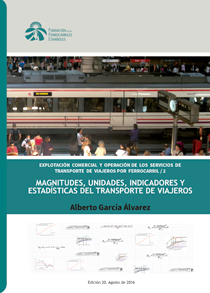
Categories
Publications
Magnitudes, units, indicators and statistics of passenger transport

The book has its origin in another one titled “Operation of passenger trains. Keys to advanced management of the railway”, which the author published together with Alberto Cillero and Pilar Jericó in March 1998 and which was edited by Fundación de los Ferrocarriles Españoles (Spanish Railways Foundation) as part of the activities developed to celebrate the 150th anniversary of the Spanish railway.
The commercial operation of passenger transport services has its own characteristics and therefore requires the use of magnitudes, units, variables and indicators in accordance with the nature of the business and its specific characteristics. The magnitudes and units that refer basically to transport and production aim to measure certain characteristics of the service to evaluate its costs, efficiency, profitability or the adjustment between supply and demand. Different names apply to each of the magnitudes, units and indicators depending on the mode of transport being studied, but they do not differ in essence. The case of the railway is the most complex, since supply can be organised in trains of varying capacity. What’s more, passenger rail services often have many stops, which introduces more complexity than, for example, air transport. For this reason, we will take the railway as a reference in the development of those topics related to the magnitudes and units of transport, although the concepts defined for the railway can be applied to other modes of transport.
Download book (pdf - free) »


